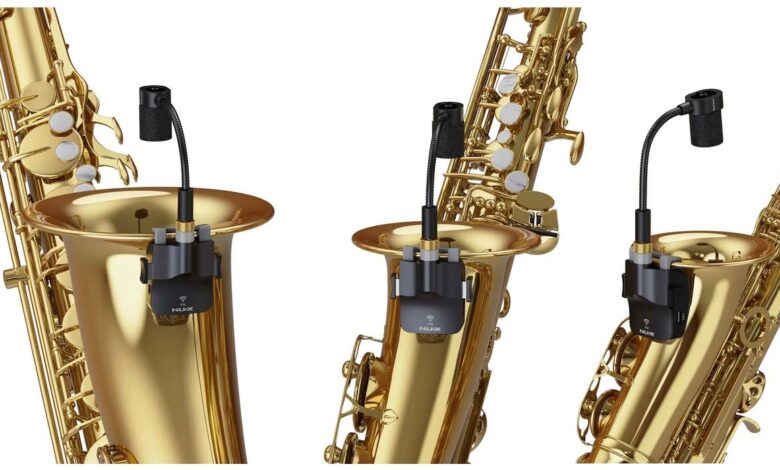Use Elastic Bands to Hold Wireless Transmitter on Saxophone

If you play the saxophone and use a wireless transmitter, you might need a way to keep it in place. Elastic bands to hold wireless transmitter on saxophone can be a great solution. These bands help secure the transmitter so it doesn’t move around while you play.
Elastic bands to hold wireless transmitter on saxophone are easy to use and can make your performance smoother. Just wrap the bands around the saxophone and the transmitter. This keeps everything snug and ready for your next gig!
Why Use Elastic Bands to Hold Wireless Transmitter on Saxophone
Using elastic bands to hold a wireless transmitter on your saxophone is a smart choice for many reasons. First, these bands keep your transmitter securely in place. This means you won’t have to worry about it moving around or falling off while you play.
Another benefit is how simple it is to use elastic bands. Just wrap them around your saxophone and the transmitter. It’s quick and doesn’t need special tools. So, you can focus on playing your music without any distractions.
Also, elastic bands are very affordable. You don’t need to spend a lot of money to keep your transmitter secure. They come in different sizes and strengths, so you can find the perfect fit for your saxophone.
How Elastic Bands Keep Your Wireless Transmitter Secure
Elastic bands help keep your wireless transmitter secure by holding it tightly against your saxophone. When you use these bands, they stretch and wrap around the transmitter and the saxophone. This creates a snug fit, preventing the transmitter from moving or shifting.
When you play your saxophone, there’s a lot of movement and vibrations. Elastic bands are strong enough to handle this without letting your transmitter slip. They help keep everything steady, so you can focus on making great music.
For the best results, choose elastic bands that are strong and stretchy. This will ensure that they can hold your transmitter securely. Adjust the bands as needed to make sure they fit just right.
Step-by-Step Guide to Using Elastic Bands for Your Saxophone
Using elastic bands for your saxophone is easy if you follow these simple steps. First, get a few elastic bands that are strong and stretchy. Next, place the wireless transmitter where you want it on your saxophone.
Now, wrap the elastic bands around the transmitter and the saxophone. Make sure the bands are tight but not too tight. You want the transmitter to be secure but still easy to remove if needed.
Finally, check to make sure everything is in place. Play your saxophone to see if the transmitter stays steady. If it moves, adjust the bands to get a better fit.
Best Types of Elastic Bands for Saxophone Transmitters
Choosing the best elastic bands for your saxophone transmitter is important. Look for bands that are strong and durable. They should be able to hold your transmitter securely without breaking or stretching too much.
Rubber bands and silicone bands are great choices. Rubber bands are stretchy and can hold tight, while silicone bands are more durable and less likely to wear out. Both types can keep your transmitter in place while you play.
Also, consider the size of the bands. They should be wide enough to wrap around the transmitter and saxophone comfortably. This will help ensure a snug and secure fit.
How to Choose the Right Elastic Bands for Your Saxophone

Choosing the right elastic bands for your saxophone involves a few simple steps. First, think about the size of your transmitter and saxophone. You need bands that are the right size to fit around them.
Next, check the strength of the bands. They should be strong enough to hold the transmitter securely but not too tight to damage your saxophone. Stretchy bands work well because they can adjust to different sizes.
Finally, try out different types of bands to see which works best for you. Some people prefer rubber bands, while others like silicone. Choose the type that feels most comfortable and secure for your needs.
Tips for Installing Elastic Bands on Your Saxophone
Installing elastic bands on your saxophone can be done easily with a few helpful tips. Start by placing your wireless transmitter where you want it on the saxophone. Then, take your elastic bands and wrap them around the transmitter and the saxophone.
Make sure the bands are evenly spaced and not too tight. You don’t want them to be so tight that they damage your saxophone or transmitter. Adjust the bands as needed to get a secure fit.
Lastly, check the bands regularly to ensure they are still in good condition. Replace them if they start to wear out or lose their elasticity. This will keep your transmitter secure and your saxophone in great shape.
Benefits of Using Elastic Bands to Hold Wireless Transmitter on Saxophone
Using elastic bands to hold a wireless transmitter on your saxophone offers several benefits. First, they are easy to use and don’t require any special equipment. Just wrap them around and you’re done.
Another benefit is the cost. Elastic bands are very affordable, making them a budget-friendly choice. They can be found at most stores and come in different sizes and strengths.
Additionally, elastic bands are versatile. They can be used in many different ways and adjusted to fit various sizes. This makes them a convenient option for keeping your transmitter secure.
Elastic Bands vs. Other Methods to Secure Your Saxophone Transmitter
Elastic bands are a popular choice for securing saxophone transmitters, but there are other methods too. For example, some people use clips or straps. These options can be more rigid and may require more setup.
Comparing elastic bands to other methods, bands are often simpler and cheaper. They can be adjusted easily and don’t need any special tools. On the other hand, clips and straps might offer a more permanent solution but can be more expensive.
Choosing between elastic bands and other methods depends on your personal preference. If you want something quick and affordable, elastic bands are a great option.
Troubleshooting Common Issues with Elastic Bands on Saxophone
If you encounter issues with elastic bands on your saxophone, there are a few things you can do. First, check if the bands are too loose or too tight. Adjust them to make sure they fit just right.
Another common problem is the bands wearing out over time. If they start to lose their elasticity or break, replace them with new ones. This will ensure your transmitter stays secure.
Lastly, make sure the bands are not interfering with your playing. They should hold the transmitter in place without affecting your ability to play your saxophone comfortably.
How to Adjust Elastic Bands for the Perfect Fit on Your Saxophone
Adjusting elastic bands for the perfect fit on your saxophone is easy with these tips. Start by wrapping the bands around your transmitter and saxophone. Ensure they are not too tight or too loose.
If the bands are too tight, they might damage your saxophone or make it uncomfortable to play. If they are too loose, the transmitter may move around. Adjust the bands until you find a comfortable and secure fit.
Test the fit by playing your saxophone. Make sure the transmitter stays in place and doesn’t shift. Adjust the bands as needed to get the best fit for your needs.
Creative Ways to Use Elastic Bands to Hold Wireless Transmitter on Saxophone
Elastic bands can be used in creative ways with your saxophone transmitter. One idea is to use different colors or patterns of bands to make your setup look unique. This can add a personal touch to your saxophone.
Another creative use is to layer the bands for extra security. If one band isn’t enough, try using two or more bands to keep the transmitter in place. This can help ensure it doesn’t move during your performance.
You can also experiment with different band sizes and strengths. Mixing and matching bands can help you find the perfect combination for your saxophone and transmitter.
Maintaining Your Elastic Bands for Long-Lasting Use on Saxophone
To make sure your elastic bands last a long time, follow these maintenance tips. First, regularly check the bands for signs of wear or damage. If they start to stretch out or break, replace them.
Keep your bands clean and free from dirt or debris. Dirt can weaken the bands and reduce their effectiveness. Wash them gently if needed and let them dry completely before using them again.
Finally, store your elastic bands properly when not in use. Keep them in a cool, dry place to prevent them from becoming brittle. This will help extend their lifespan and keep your transmitter secure.
How to Store Elastic Bands for Your Saxophone Transmitter
Storing elastic bands properly is important to keep them in good condition for your saxophone transmitter. Start by keeping them in a dry place. Moisture can make the bands lose their elasticity and become weak.
Use a small container or bag to keep the bands organized. This helps prevent them from getting tangled or damaged. A cool, dry drawer or a small box works well for this purpose.
If you have multiple bands, consider separating them by size or color. This makes it easier to find the right band when you need it. Also, avoid storing bands in direct sunlight, as UV rays can degrade the material over time.
The Role of EElastic Bands to Hold Wireless Transmitter on Saxophone Performances
Elastic bands play a key role in saxophone performances by securing your wireless transmitter. They ensure that the transmitter stays in place, which helps you focus on your playing instead of worrying about equipment shifting.
During a performance, elastic bands help reduce distractions. By keeping your transmitter steady, they make sure your audio signal remains clear and uninterrupted. This is important for delivering a smooth and professional performance.
Additionally, using elastic bands can enhance your confidence. Knowing that your equipment is secure allows you to concentrate fully on your music and performance, making for a more enjoyable experience for both you and your audience.
Comparing Elastic Bands to Hold Wireless Transmitter on Saxophone Mounting Options
When it comes to mounting your wireless transmitter on your saxophone, elastic bands are just one option. Comparing them to other methods, like clips or specialized holders, can help you decide what works best for you.
Elastic bands are flexible and easy to use. They don’t require any special tools and can be adjusted quickly. This makes them a great choice for many musicians who need a simple and cost-effective solution.
On the other hand, clips and holders can offer a more rigid and permanent setup. These options might be more secure but could also be more expensive and less adjustable. Weighing the pros and cons of each method can help you choose the best one for your needs.
How to Replace Worn-Out Elastic Bands on Your Saxophone
Replacing worn-out elastic bands on your saxophone is a straightforward process. First, inspect your bands regularly for signs of wear, such as stretching, tearing, or brittleness.
When you notice that a band is no longer effective, remove it carefully from your saxophone and transmitter. Be sure to dispose of the old band properly and replace it with a new one.
Choose a new band that matches the size and strength of the old one. Follow the same steps you used for installation to wrap the new band securely around your transmitter and saxophone. This will ensure your setup remains stable and reliable.
DIY Tips for Making Your Own Elastic Bands for Saxophone
If you prefer a DIY approach, you can make your own elastic bands for your saxophone transmitter. Start by choosing a suitable elastic material. Look for something stretchy and durable, like rubber or silicone.
Cut the material into strips that are long enough to wrap around your transmitter and saxophone. Be sure to make the strips slightly longer than you think you’ll need, as you can always trim them to fit.
Once you have your strips, you can stretch and wrap them around your equipment. Adjust the bands as needed to ensure a secure fit. Making your own bands allows for customization and can be a fun project for any musician.
Using Multiple Elastic Bands to Hold Wireless Transmitter on Saxophone
Sometimes, using just one elastic band isn’t enough to keep your wireless transmitter secure. In such cases, using multiple bands can provide extra security.
Start by wrapping one band around your transmitter and saxophone as usual. Then, add a second band, placing it in a different position. This creates a more secure hold and prevents the transmitter from moving.
Make sure each band is snug but not too tight. You want to ensure that your transmitter is secure without causing any damage to your saxophone. Multiple bands can offer added stability and help keep your setup in place during even the most energetic performances.
Benefits of Using Colored Elastic Bands for Saxophone Transmitters

Using colored elastic bands for your saxophone transmitter can be both practical and fun. Different colors can help you quickly identify which band to use, especially if you have several sizes or types.
Colored bands can also add a personal touch to your saxophone setup. You can choose colors that match your style or outfit, making your equipment look more distinctive.
In addition, colored bands can be helpful for organizing and storing your elastic bands. By using different colors, you can easily separate and locate the bands you need, making your setup process quicker and more efficient.
How to Ensure a Perfect Fit with Elastic Bands to Hold Wireless Transmitter on Saxophone
Ensuring a perfect fit with elastic bands on your saxophone is key to keeping your wireless transmitter secure. Start by choosing bands that are the right size for your equipment. They should be stretchy enough to hold the transmitter but not so tight that they cause damage.
Wrap the bands around the transmitter and saxophone, adjusting as needed. Make sure the bands are evenly spaced and not overlapping too much. This helps distribute the pressure evenly and provides a secure fit.
Test the fit by gently moving the transmitter to see if it stays in place. If it shifts or feels loose, adjust the bands until you achieve the perfect fit. A well-secured transmitter will help you perform confidently and smoothly.
How to Clean Elastic Bands Used for Your Saxophone
Cleaning elastic bands used for your saxophone is important to keep them in good condition. Start by removing the bands from your equipment. Gently wash them with mild soap and water to remove any dirt or grime.
After washing, rinse the bands thoroughly to ensure all soap is gone. Let them air dry completely before putting them back on your saxophone. Avoid using heat or direct sunlight to dry them, as this can damage the elastic material.
Keeping your bands clean helps maintain their elasticity and prolongs their life. Regular cleaning ensures that your bands continue to provide a secure hold for your wireless transmitter.
Common Mistakes to Avoid with Elastic Bands to Hold Wireless Transmitter on Saxophone
When using elastic bands on your saxophone, there are a few common mistakes to avoid. One mistake is using bands that are too tight. Tight bands can cause damage to your saxophone or make it uncomfortable to play.
Another mistake is using bands that are too loose. Loose bands may not hold the transmitter securely, which can lead to it moving or falling off. Always check the fit of the bands and adjust them as needed.
Finally, don’t use bands that are worn out or damaged. Old or brittle bands may not provide the support you need. Regularly inspect and replace bands to ensure your transmitter stays securely in place.
Conclusion
Using elastic bands to hold a wireless transmitter on your saxophone is a simple and smart way to keep everything secure. These bands are easy to use, affordable, and help prevent your transmitter from moving while you play. By wrapping the bands around your saxophone and transmitter, you can focus on your music without worrying about equipment shifting.
Remember to choose the right size and type of bands for the best fit. Keep an eye on them to make sure they stay in good shape. With the right care, elastic bands will keep your saxophone setup steady and your performances smooth.



